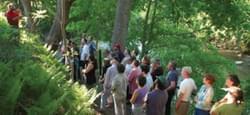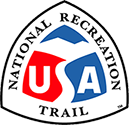




River Walk was created by community volunteers, and maintained to allow public access to the Housatonic River and to reclaim its banks for the benefit of wildlife and people.


Designated in 2009
• View more details for this trail
in the NRT Database
• Learn about the NRT Program.
Housatonic River Walk is a riverside greenway trail in the downtown center of Great Barrington, Massachusetts, providing a half-mile of artfully crafted riverside walking trail and canoe access.
River Walk is located adjacent to Great Barrington’s Main Street, yet offers a rare nature experience of river and wildlife views. River Walk develops riverfront access in a densely populated setting, permitting pristine riparian areas to remain forever wild.
Approximately 5,000 residents and tourists visit this popular downtown site yearly and experience simple methods of natural resource protection—native plant vegetative buffers, invasive-exotic plant control, non-toxic compost tea soil enhancements, local non-toxic trail materials, and non-point source pollution controls with raingardens, drop inlets, and permeable trail surfaces. River Walk’s William Stanley Overlook and W.E.B. Du Bois River Park promote the river’s significance to industrial and civil rights leaders of national and international importance.
Creating a diverse native plant community is the keystone of our reclamation work. Layered plantings contribute to surface water quality by shading and cooling. More than two hundred different native species have been planted along the riverbank, many propagated from seed collected locally.
Native plants are the keystone of reclamation work along the Housatonic River. They contribute to surface water quality by shading and cooling the river and by stabilizing the bank, preventing erosion and river siltation. Native plants contribute to riparian reclamation by cleansing and taking up pollutants and by replacing non-native invasive plants, which in turn increases biodiversity and expands wildlife habitat and food sources.
When using bioengineering techniques to help stabilize a bank section, volunteers cut stems along the River Walk from existing stoloniferous plants such as willows and shrubby dogwoods. The stems can be used as live stakes that penetrate the bank, or bundled into fascines whose live stems will root in place and hold the soil.
Once established, the branches and leaves protect the soil from erosion by wind and rain, while trapping organic matter to develop soil in the future. Sometimes stems are cut by beaver that travel the river in early spring, seeking new home sites and food sources. No matter who does the cutting, it often encourages root production in the parent plant, further stabilizing the riverbank.
River Walk is an outdoor classroom educating students from kindergarten through graduate school. Workshops, tours, lectures and learning service programs teach about the restoration of riverine environments and local history. Interns from regional colleges assist with all aspects of development and maintenance, as they learn how to reclaim a riverine ecosystem and about the practicalities of maintaining a public space.
River Walk reclaims south Berkshire County’s most severely abused riverbank. As Great Barrington developed during the industrial revolution, the Housatonic River became a “working” river spoiled by dioxins, raw sewage, PCBs, and everyday household waste. Many towns like Great Barrington were built with their backs to the river, abused by years of neglect. Now the river is seen as a natural treasure with spectacular views and wildlife such as bald eagle, osprey, kingfisher, egret and great blue heron.
Since 1988, 2150 community volunteers have contributed clean up, construction and maintenance, removing over 375 tons of debris, building the trail and planting thousands of native plants. Approximately 5,000 residents and tourists visit this popular downtown site yearly and experience simple methods of natural resource protection—native plant vegetative buffers, invasive-exotic plant control, non-toxic compost tea soil enhancements, local non-toxic trail materials, and non-point source pollution controls with raingardens, drop inlets, and permeable trail surfaces.
River Walk’s artfully crafted trail system utilizes several techniques—stone cribbing, gabion, elevated walkways. Each trail section is tailored to a unique riverside setting. More than half of the trail is wheelchair accessible.
While excavating soil to place a gabion in this area, Comstock Small found a Native American hunting spear point made of Hudson Valley chert. Here, volunteers removed more than ten tons of assorted household rubbish, including numerous Spam and Schaefer beer cans from the 1950’s, assorted shoes and plumbing parts. Upstream, votive candle shards, plastic flowers, and slate roofing tiles were taken from behind the church. Perfume bottles, decanters, and boxes of cigars were removed from the old Melvin’s Pharmacy, together with a 1961 Town of Great Barrington bicentennial coin and a large concrete safe.
Along the river, in 1886, electrical inventor William Stanley developed his alternating-current transformer. His laboratory was in Horace Day’s rambling, vacant rubberwear factory, the foundation of which is still visible. From here, Stanley ran wires across the river to light stores and offices on Great Barrington’s Main Street. Stanley’s innovation allowed efficient, long-distance transmission of power. He went on to establish a manufactory of transformers and other electrical products in Pittsfield in the 1890s that evolved into General Electric.
The William Stanley Overlook, a tribute to Great Barrington’s industrial heritage, was dedicated on June 3, 2006 with three generations of Stanley descendants attending. Property developer Dale Culleton donated the limestone from local sources for the cul de sac.
Great Barrington Land Conservancy PO Box 1018, Great Barrington MA 01230 Phone: (413) 528.3391 Website address: www.gbriverwalk.org